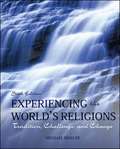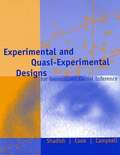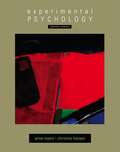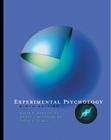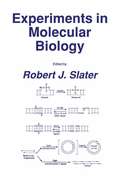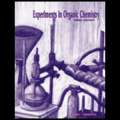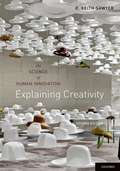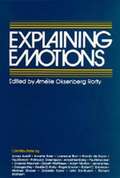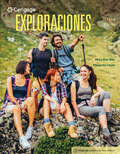- Table View
- List View
Experiencing the World's Religions: Tradition, Challenge, and Change (Sixth Edition)
by Michael MolloyMichael Molloy's multi-dimensional examination of religions, combined with Connect Religion's skills-based activities, provides an intimate learning experience for students. Experiencing the World's Religions integrated program supports today's students and provides skills that extend beyond the Introduction to Religion course, engaging both non-majors and majors in the subject. The goal of the 6th edition is to better meet the Introduction to Religion course challenges of building student engagement, developing critical analysis skills, and building writing skills. The 6th edition of Experiencing the World's Religions continues to include primary sources, current examples, and coverage of women, to ensure students are introduced to unfamiliar religions in ways that are accessible, inviting, and intriguing. Experiencing these concepts and cultures is the hallmark of Michael Molloy's approach. His pedagogy and activities are now fully integrated and assessable within Connect Religion, to make for an increased understanding of the most important and memorable elements of each religion. Writing activities in Connect Religion, tied to chapter narrative, offer students the chance to develop their critical analysis skills and put their informed opinions on religion into writing. The result is greater student engagement and greater course success.
Experimental And Quasi-experimental Designs For Generalized Causal Inference
by Thomas D. Cook Donald T. Campbell William R. ShadishThis long awaited successor of the original Cook/Campbell Quasi-Experimentation: Design and Analysis Issues for Field Settings represents updates in the field over the last two decades. The book covers four major topics in field experimentation.
Experimental Psychology
by Christine H. Hansen Anne MyersFocusing on experimental methods, authors Anne Myers and Christine Hansen lead students step by step through the entire research process, from generating testable hypotheses to writing the research report. The major sections of the book parallel the major sections of a research report (Introduction, Method, Results, and Discussion), giving students the skills they'll need to design and conduct an experiment, analyze and interpret the research findings, and report those findings. Although the main focus is on experimentation, alternative approaches are discussed as important complements.
Experimental Psychology
by Henry L. Roediger Barry H. Kantowitz David G. ElmesUNDERSTANDING PSYCHOLOGY RESEARCH, Ninth Edition, takes an example-based approach to the fundamentals of research methodology. Organized by topic--such as research in human factors, learning, thinking, and problem solving--the text helps you connect the concepts of sound methodology with their practical applications. Because the authors use dozens of carefully selected real-world examples, you can see for yourself the issues and problems that can occur in conducting research. More importantly, you can develop a sense of how to anticipate and adjust for problems in your own research.
Experimenting with Forces and Motion, Student Guide
by National Science Resources Center Taina Litwak Dane J. TolerNIMAC-sourced textbook
Experimenting with Mixtures, Compounds, and Elements, Student Guide
by National Science Resources Center Kitty Lou Smith Susie DuckworthNIMAC-sourced textbook
Experiments in Molecular Biology
by Robert J. SlaterResearch in the field of molecular biology has progressed at a fascinating rate in recent years. Much of this progress results from the development of new laboratory techniques that allow very precise fractionation and analysis of nucleic acids and proteins, as well as the construction of recombinant DNA molecules that can then be cloned and expressed in host cells. Progress has been so rapid that there has been a shortfall in the training of appropriately qualified staff. Many existing laboratory workers require retraining, and many educational institutions have had difficulty incorporating the new molecular biology techniques into their teaching programs. Although there are several manuals currently available that describe laboratory techniques in molecular biology, they are principally written for the individual research worker and are not intended for use in the design of practical classes for students. The aim of this book is to provide just such a series of protocols for the teaching of practical molecular biology. The idea arose following the success of several Workshops in Molecular Biology, organized and taught by staff in the Biology Department of the Hatfield Polytechnic. Gradually, the protocols used in the workshops have been incorporated into the Hatfield undergraduate and postgraduate teaching pro grams and have now been collected together to form a book.
Experiments in Organic Chemistry
by Richard Hill John BarbaroThis laboratory manual is intended for use in an introductory course in organic chemistry. The authors have used it both in the full-year course for chemistry majors and premedical students and in shorter sequences designed for students in the biological sciences, pharmacy, nursing, agriculture, and nutrition. A unique feature of this manual is the inclusion of a number of Mystery Reactions. These are experiments in which the outcome and nature of the reaction product are not given, posing a mystery for the student to solve. The organic chemistry laboratory provides a wonderful opportunity to practice the application of logical reasoning and deduction in the solution of structural problems.
Experiments with Plants: Student Investigations
by National Science Resources CenterNIMAC-sourced textbook
Explaining Creativity: The Science of Human Innovation
by R. Keith Sawyer<p>Explaining Creativity is an accessible introduction to the latest scientific research on creativity. The book summarizes and integrates a broad range of research in psychology and related scientific fields. In the last 40 years, psychologists, anthropologists, and sociologists have devoted increased attention to creativity; we now know more about creativity than at any point in history. Explaining Creativity considers not only arts like painting and writing, but also science, stage performance, business innovation, and creativity in everyday life. <p>Sawyer's approach is interdisciplinary. In addition to examining psychological studies on creativity, he draws on anthropologists' research on creativity in non-Western cultures, sociologists' research on the situations, contexts, and networks of creative activity, and cognitive neuroscientists' studies of the brain. He moves beyond the individual to consider the social and cultural contexts of creativity, including the role of collaboration in the creative process.</p>
Explaining Emotions
by Amelie Oksenberg RortyThis volume approaches the problem of characterizing and classifying emotions from the perspectives of neurophysiology, psychology, social psychology and philosophical psychology and discuss the difficulties that arise in classifying, assessing and determining the emotions.
Exploraciones
by Mary Ann Blitt Margarita CasasEXPLORACIONES transforms students into culturally competent Spanish speakers by providing learning strategies, systematic self-assessments, integration of the National Standards, and a focus on the practical purposes of language study.
